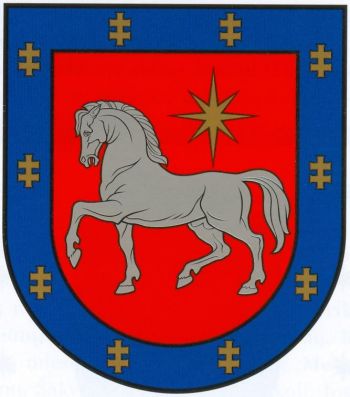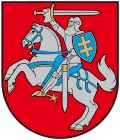Utena (county)
UTENA COUNTY
| Lithuanian | blazon wanted |
| English | blazon wanted |
Origin/meaning
The arms were granted on August 16, 2004.
On the beginning of historic times the Selonians lived in the large part of contemporary Utena county. When the Lithuanian state was establishing, the majority of this area depended to the Nalšia land. Daumantas, the last duke of Nalšia, was among the plotters who killed the King Mindaugas. It is usually considered that Daumantas' capital was Utena.
During the civic war of 1263 Daumantas abandoned Lithuania and escaped to Pskov. Since that time Nalšia depended to the Grand Dukes of Lithuania. However it was not included into the domain but ruled by vicegerents. The ancient names Selonia and Nalšia became obsolete, and the name Uzneris appeared, mentioning the large "wild" (from feudal point of view) area. The establishment of fieves and serfdom here was not easy and lasted till the early 17th century.
During the administrative reform of 1564-1566 the majority of this area was attributed to Vilkmerge (now Ukmerge) district of Vilnius province, and the northern corner was attributed to Breslauja (now Braslav in Belarus) district.
During the time of Russian Empire those lands depended to the Vilkmerge and Novoaleksandrovsk (now Zarasai) districts.
The origin of Utena county is December 4, 1915, when the occupational German regime established the Utena district (Bezirk) in the Lithuania province of Oberost. The first Lithuanian administration of the county was established in December of 1918, but soon the land was occupied by the Red Army. Therefore the Lithuanian county (apskritis) and administration were officialy established only after the expulsion of communists in 1919.
In 1950 the county was abolished, and in 1994 the Utena county was re-established.
Utena county had no historic arms. Looking for the symbol of land, the deep ancient tradition of horsebreading was mentioned. This tradition is related to the sacred status of horse (especially the white one) in Lithuanian culture. In modern times, the Utena county is most famous for the horse sports and horse races. That was one of reasons why in 1969 the horseshoe was shown in the arms of Utena city.
With the allowance of local administration, the arms of Utena county show two symbols: on red field the white horse and golden eight-pointed star.
The horse symbolizes the ancient tradition of horsebreading and horse sports. Also it is a kind of citation from the Utena city arms: the city is related to the county like the horseshoe is related to horse. Also the horse is some citation of National Arms, as the Utena county is the part of Aukštaitija region. Also horse symbolizes the freedom, intelligence and luck.
The eight-pointed star shows the administrative center of county: the Utena city. It also symbolizes the renaissance and knowledge.
The red field is the traditional color of Vilnius province banners. It also symbolizes the fight for freedom.
Lithuania heraldry portal
This page is part of the Lithuania heraldry portal |
Heraldry of the World |
|
Civic heraldry:
|
Other heraldry: |
Contact and Support
Partners:
Your logo here ?
Contact us
© since 1995, Heraldry of the World, Ralf Hartemink 
Index of the site
Literature: Information and image provided by Virginijus Misiunas, Vilnius.












